Those bright mystery spots aren’t the only ones on Ceres. Recent photos posted on JPL’s Photojournal site feature a spectacular rayed crater resembling the familiar lunar craters Kepler and Copernicus.
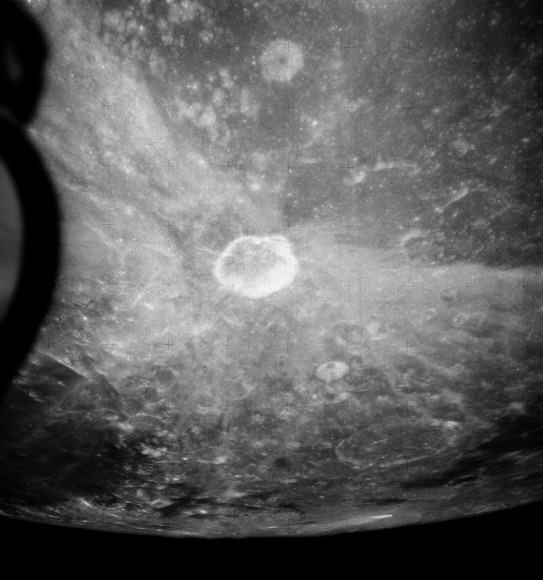
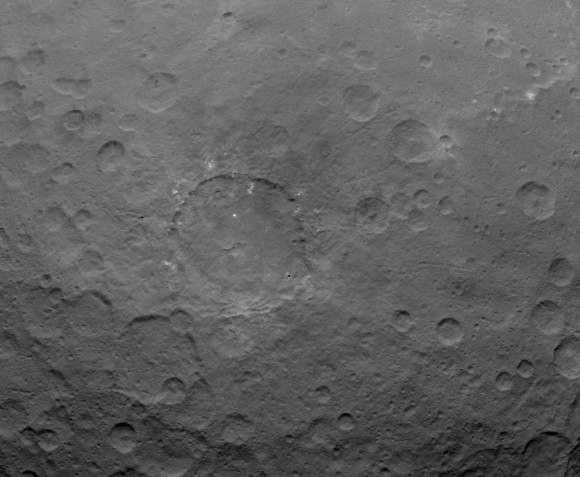
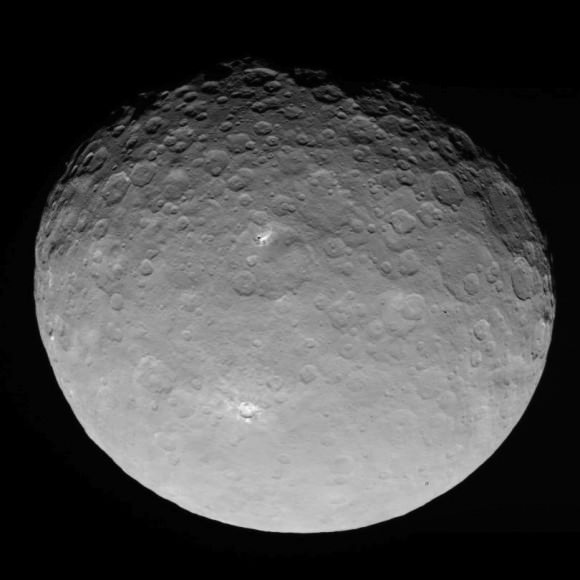
Lunar rays are bright because they contrast with their older surroundings which have been darkened by exposure to solar and cosmic radiation. Impacts expose fresh material from below the surface that settles into a spider web of rays around the newly excavated crater. Huge boulders lofted above the Moon’s surface during the impact slam back into the crust to create secondary craters also crowned with bright dust and rock.
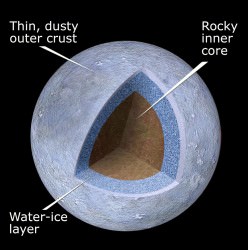
Most models of Ceres depict a rocky crust, mantle of ice and a rocky inner core. This makes us wonder if the bright material unearthed might be ice. If so, it would gradually vaporize on the virtually air-free dwarf planet.
Dawn will spend through early 2016 at Ceres during its primary mission and then remain in orbit there perpetually. We should be able to cipher the composition of the white material during that time with the spacecraft’s Gamma Ray and Neutron Detector and Visible and Infrared Mapping Spectrometer, but a lengthy stay might allow us to see changes in the extent of any ice exposures as they gradually vaporize away.
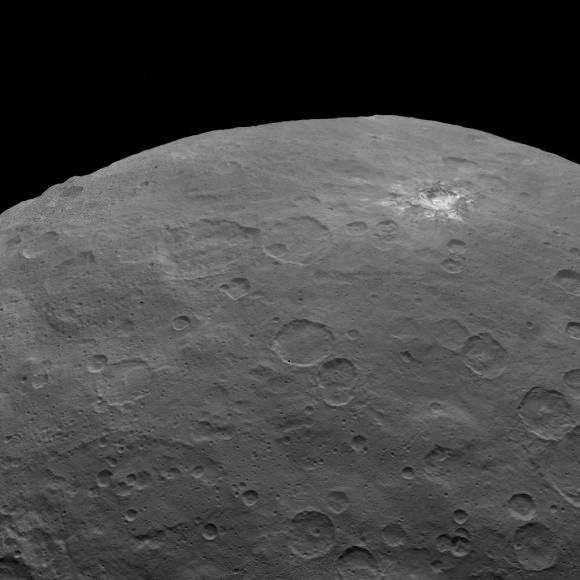
One thing we know for certain about Ceres are its dimensions. Dawn observations have revised the size to be about 599 miles (963 km) across at the equator with a polar diameter of 554 miles (891 km). Like Earth and other planets, Ceres is a slightly flattened sphere wider at the equator than from pole to pole. The temperature there ranges from about -100°F (-73°C) during the day and dips to -225°F (-143°C) at night. That makes its daytime high about 28° warmer than coldest temperature ever recorded on Earth.

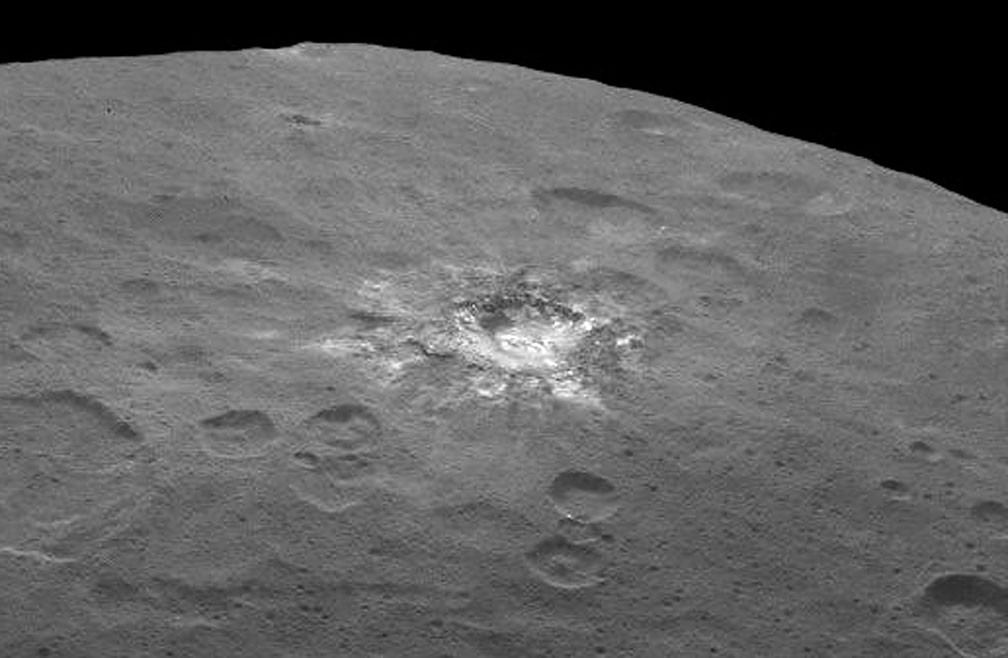
Hi Bob,
The uncropped untoned image looks like the result of an impact from a Vesta family asteroid, Nancy has had a short note from me giving more background to my idea. As you say I think ice would sublime and salt seems unlikely. We do have bits of Vesta on Earth so it is not impossible.
Roseland Observatory.
Could you explain, briefly, why frozen water, so far below its freezing point would sublimate, and how rapidly that would happen? If that is the case, then wouldn’t that serve to give us an upper limit to the age of the impacts observed? When you think about it, each impact could have happened as late as just before the period of the probe’s observation, right?
Bill,
Ice can still sublimate because the air pressure is nil and temperature “relatively” warm. No where near absolute zero anyway. Think of ice and water that disappear from a sidewalk even on a sunny though bitter cold day.
Bill,
It’s also very possible that Ceres’ ice is a mix of several kinds of ices in the form of an amorphous ice or clathrate which can vaporize at low temperatures.
How young can the rayed crater and the “teardrop” crater be?
800 years? Less?
Zoutsteen,
Wish I knew. I’d guess closer to a geologic time scale.
Where does the number 800 come from? Does it have some special significance?
Being geologically differentiated into core, mantle, and crust, plus being rounded by its own gravity are why Ceres is a small planet.
Organic Compounds, interesting!
I’d go with a “mostly water-ice beneath a veneer of dust” explanation for the upper crust of Ceres. When a fresh impact occurs, the rays and crater melt/deposits are a mixture of ice and impactor material (mineral or “dust”). Over time, the volatiles sublimate away, leaving the dust. Since the rays are thin, these disappear first, leaving the main crater exposed as a bright “point”. While salts are likely present in the ice, there is really no need to rely on salts as the high albedo material. This is analagous to “light haloed craters” on the Moon, where an impact occurred over a thin layer of mare basalt, which overlays lighter-colored lunar highlands material. The impact excavates the lighter-colored highlands rock and deposits it around the crater, creating a bright spot in a dark “sea”.
Well then… it looks like our ‘mystery’ has been solved? Somewhat… NO the two bright spots weren’t manufactured by aliens or even created by cryo-volcanism, instead they are simply meteor impacts upon an icy crust. What is now interesting is the dual nature of the first two bright spots which may indicate either a co-orbital component in the event, or the breakup of a loosely packed cometary body as it approached Ceres?